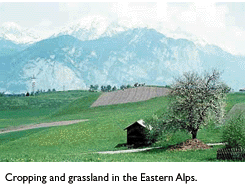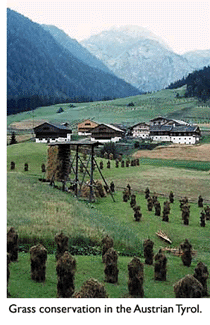 This page has been mothballed.
This page has been mothballed.
It is no longer being updated but we've left it here for reference.
Integrating environmental concerns into european mountain agriculture.

- Collaborators
- Euromontana, Paris (Co-ordinator)
- Aristotle University of Thessaloniki, Greece
- Bundesandsalt für Bergbauernfragen, Vienna
- IKT, Vitoria-Gasteiz, Spain
- INRA, Castanet Tolosan, France
- GIS Alpes du Nord, SUACI Montagne du Nord, France
The study used 25 agricultural case study areas in the main mountain regions of Europe to investigate the links between agricultural change and the environment. Two case study areas (in Sweden and Finland) were not in mountainous regions but had equivalent conditions and conformed to Directive 905/97. The project structure was unusual and ambitious. Five network leaders were established for each of five geographical zones. In each network around five research groups with local knowledge were asked to participate a total of 25 research groups for the whole project. Bob Crabtree and Daisy MacDonald from the Macaulay organised the Nordic network of Scotland, Sweden and Finland and assisted in the central organisation of the project.
 The analytical approach was pressure-state-response,
attempting to understand the processes of change and their impact on
environmental quality. All zones were affected by pervasive socio-economic
pressures driving agricultural change but the responses differed depending on
the area. In most cases abandonment of land or of traditional agricultural
practices was occurring with a loss of agriculturally-related habitat and
landscape. The types of adaption depended on the existing farm systems with,
for example, in the case of traditional grassland farming five main types of
responses. In essentially mixed arable/cropping systems the adaption was more
typically towards monoculture, set-aside or a complete change of land use
(afforestation or abandonment). The driving force for change was usually an
attempt to maintain incomes, reduce labour costs or to reduce activities that
had high personal or social costs (e.g. utilization of high mountain pastures).
Pluriactivity was found to be widespread but its impact was ambiguous. In some
cases pluriactivity allowed the contribution of traditional farming; whereas in
others it was itself the driver of simplification, reduction in labour use and
partial or total abandonment of practices.
The analytical approach was pressure-state-response,
attempting to understand the processes of change and their impact on
environmental quality. All zones were affected by pervasive socio-economic
pressures driving agricultural change but the responses differed depending on
the area. In most cases abandonment of land or of traditional agricultural
practices was occurring with a loss of agriculturally-related habitat and
landscape. The types of adaption depended on the existing farm systems with,
for example, in the case of traditional grassland farming five main types of
responses. In essentially mixed arable/cropping systems the adaption was more
typically towards monoculture, set-aside or a complete change of land use
(afforestation or abandonment). The driving force for change was usually an
attempt to maintain incomes, reduce labour costs or to reduce activities that
had high personal or social costs (e.g. utilization of high mountain pastures).
Pluriactivity was found to be widespread but its impact was ambiguous. In some
cases pluriactivity allowed the contribution of traditional farming; whereas in
others it was itself the driver of simplification, reduction in labour use and
partial or total abandonment of practices.
The project found that the links between farming and environmental quality were complex. There was abundant evidence that farm practices supported biodiversity, valued landscapes and represented a valued cultural heritage. However, in many situations which included grassland and cropping systems, farming practices were causing environmental damage through high nutrient losses (and associated water pollution), erosion and fire-risk. Adaptation, and specifically intensification, that helped farm businesses to survive could be associated with some negative impacts.
The project examined possible policy initiatives as a response to the evolving situation. Agri-environmental measures under 2078/92 were found to be patchy in their effectiveness often through administrative problems in their application. Forestry measures were not found to be appropriate in areas already highly afforested because of the loss of landscape quality and open space. Elsewhere they represented a valuable component of biodiversity and could reduce total abandonment, erosion and fire-risk. Proposals for integrating structural and agri-environmental measures were explored and as a means of providing a more coherent basis for justifying support.

